The InterCity 62-passenger train departed from the Athens central station for the Athens – Thessaloniki route at 19:22 on Tuesday, February 28, 2023. At 23:09 it departed from Larissa station carrying 340 passengers and 12 staff, a total of 352 people. At 23:21 the IC62 collided with freight train No 63503, which was being driven by two people. After the latest DNA identifications of the reported missing persons, the death toll stands at 57 with at least 80 injured. The majority of the dead are young adults within the ages of 20-30 years. One person remains in critical condition, still battling for their life and two others recently left Intensive Care Units.
It is meanwhile unlikely that missing persons have still not been reported. Despite this, organizations working with migrants are hoping to find information on whether any migrants were on board. Migrants regularly buy their ticket in the train, and therefore are not included in the official passenger list from online reservations.
This article is a commentary piece reflecting lived experience, research and local perspectives written by a Greek resident. The views and opinions expressed don’t necessarily represent those of Unicorn Riot.
According to the information available, the Larissa station master did not put the train back on the correct line/direction. Thus, for about 25 kilometers (15.5 miles) and almost 12 minutes the passenger train was moving on the same line as a freight train.
Immediately after the accident it was revealed that on the Athens-Thessaloniki route, light signals, remote management, traffic control systems and communication systems were out of service, except on a small part of the line. Instead, the train engineers communicate by radio with the stationmaster in order to move from one station to another.
Even if one of these systems was working, the engineers would have a picture of the traffic within a radius of a few hundred miles, and before they collided they would have simply stopped at a red signal light or the automatic instant braking system would have been activated.
A day after the accident, marches and protests started in Thessaloniki and Athens and quickly spread throughout the country. The furious protests were directed at the Greek state and the private company Hellenic Train, which manages the transport service.
Signs left at a kiosk at a Thessaloniki train station on March 7 contained a variety of impactful statements (see images below):
- Big sign with red hand, “You killed three of my cousins and you give me three days to mourn?” (referring on the three days of national grief called by the premier minister)
- “It was not a mistake, it was a crime”
- “To our colleagues, that we lost so unfairly, we will not forget you”
- “Human mistake is when you spill the coffee, when you spill blood is is called a crime”
- “Our lives have value”
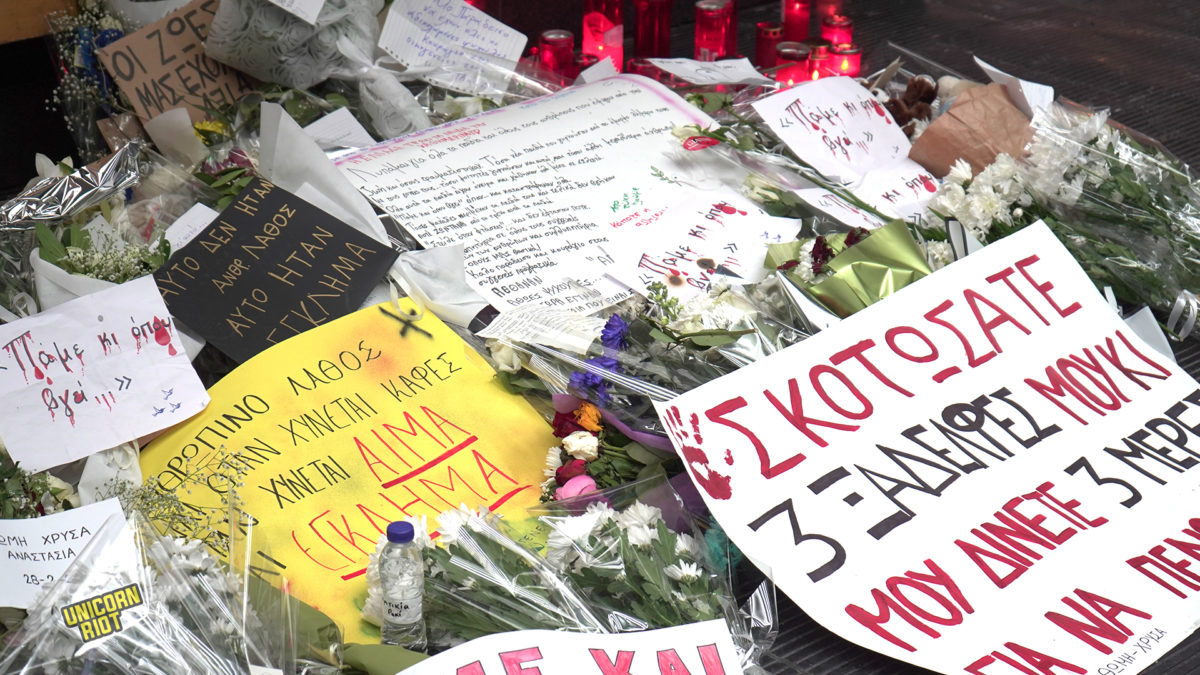
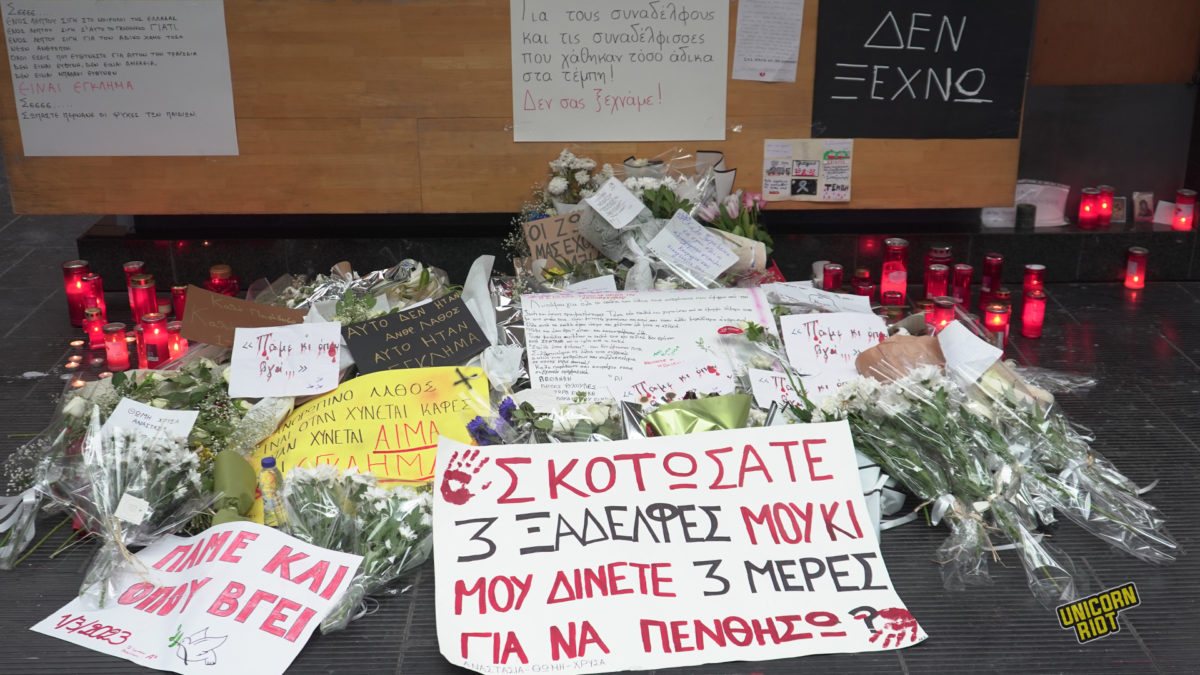
During the last 20 years and in the midst of the austerity policies imposed on Greece in the last decade, the Hellenic Railway Organization (OSE) has been devalued by the Greek state, fragmented into smaller companies and has developed, as a result, a huge debt held by private banks. In this framework, the Italian state-owned Ferrovie dello Stato Italiane Group acquired TRAINOSE, the company providing the transport service, in 2017 for just €45 million.
Following this takeover, the transport project became private, but the infrastructure remains state-owned, which means that the state, not the company, must invest in it. It now operates under the name Hellenic Train.
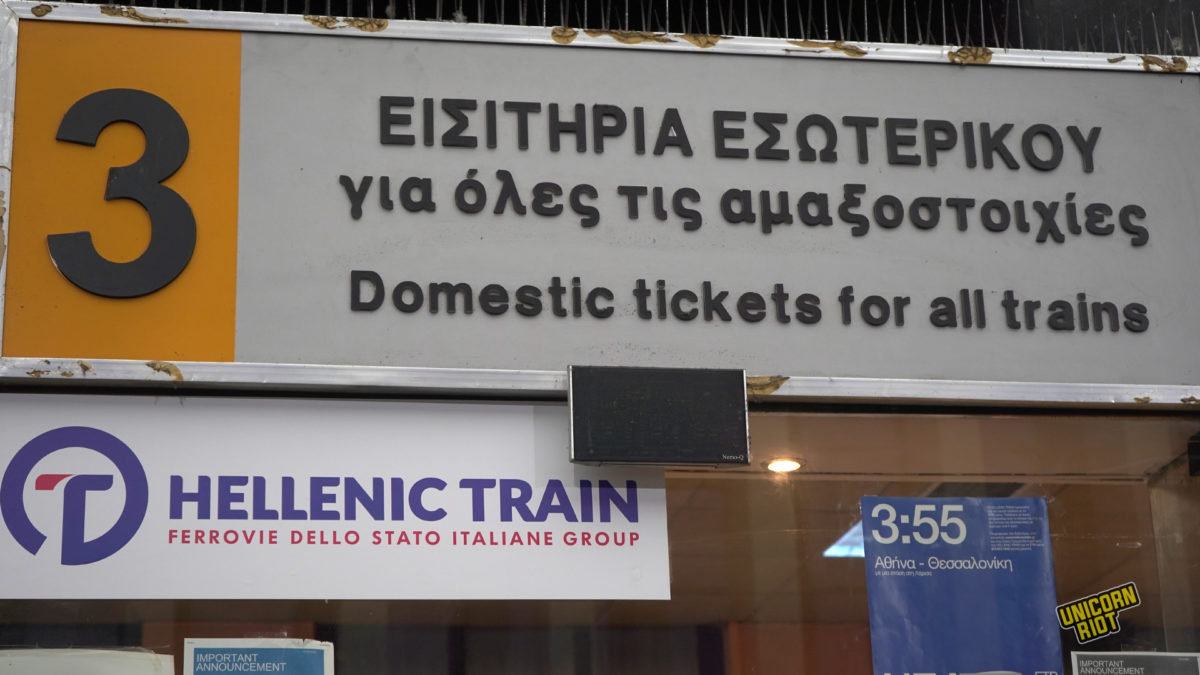
The Government’s Reaction and Strategy
Led by the far-right New Democracy party, the Greek government continued what has become a well-established strategy and narrative of individual responsibility to confuse the reactions and deflect responsibility from its own management and the Hellenic Train company.
Almost 17 hours after the accident, Transport Minister Costas Karamanlis announced his resignation. Just a week before the crash, on February 20, 2023, he had spoken in Parliament about railway safety, answering a question he said:
“I am ashamed that you raise safety issues and I would like you to recall immediately. It is a disgrace. I have explained it to you and I say it again, we are ensuring safety.”
Despite his resignation, he will be a candidate for parliament in the next elections (around the end of May) with the ruling New Democracy party.
Meanwhile, Prime Minister Kyriakos Mitsotakis combined various communication tactics and narratives to achieve a political gaslighting that would leave his party as unscathed as possible by the event and would calm the spirits in a potentially explosive social situation.
Initially Prime Minister Kyriakos Mitsotakis, in a television address, attributed the crash mainly to “human error.”
“Everything shows that the tragedy is unfortunately mainly due to a tragic human error.”
When governments and companies attribute an accident to ‘human error,’ they imply that they have created perfectly safe systems that are destroyed by the incompetence of their operators. This is in no way true of the conditions prevailing on the Greek rail networks.
The mainstream media have, from the beginning, adopted the government narrative of the “tragic human error” and the sole responsibility of the stationmaster. Only days later, after the murderous omissions of the Greek state and the Hellenic Train Company had been revealed and amidst social outcry, were they forced to present the events closer to reality.
Independent and progressive investigative media and digital platforms played a major role in uncovering the lies of the mainstream media as Greece ranks 108th in the world in terms of press freedom and last among the European Union countries.
This gap between the truth and what the Greek mainstream media presents as truth is often evident if one compares Greek news with foreign reports about Greece. Once again international press and media such as The Guardian, BBC, NY Times, Reuters and Al Jazeera reported on the responsibilities that should be placed on the Greek government due to rail safety negligence.
The government and Hellenic Train were later also exposed in a letter (pdf) to the European Commissioner for Transport, Adina Valjean, from the European Federation of Train Drivers’ Unions (ALE). ALE expressed its deepest indignation “for an event that should never [have] happened and must not be allowed to occur again.”
In the letter below, the President of ALE, Juan Jesus García Fraile, attributed the rail tragedy to a “persistent pattern of Greek rail network negligence, which leaves Greek rail transport workers and users vulnerable to this deplorable reality.”
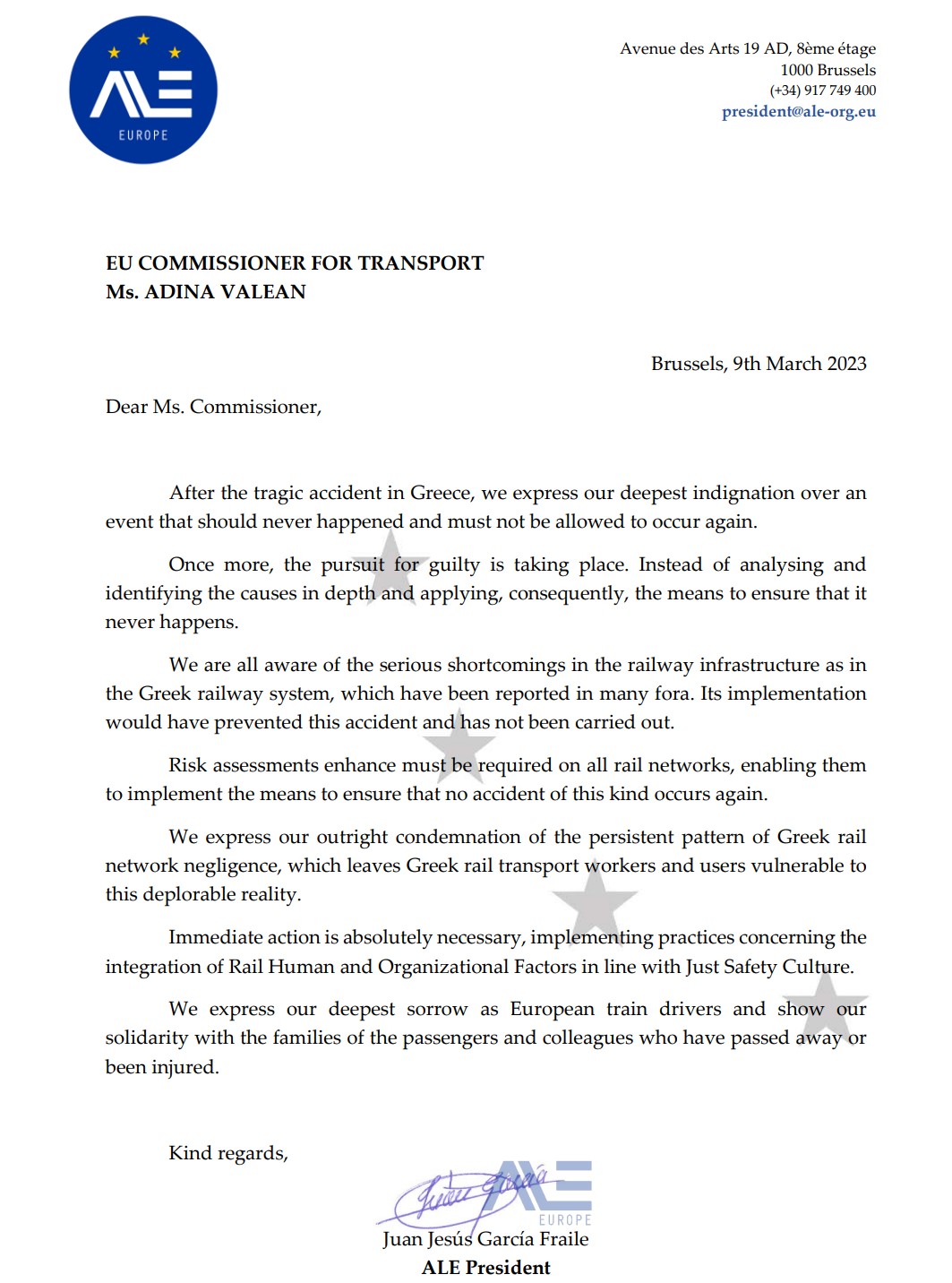
On March 9, amid backlash, Kyriakos Mitsotakis was forced to apologize and say he would not hide behind human error, but continued accusing previous governments and not taking full responsibility for the security lapses on his shift that cost the lives of 57 people.
His new narrative was: “The last thing I’m interested in right now is getting into a sterile debate about who is to blame. I answer: we are all to blame and let us admit it with courage.”
It is interesting that he decided to show his more sensitive self and to make a self-criticism in a Facebook post, used by younger people who were more involved in the protests. On TV, which is the medium most of his older voters watch, he did not present the events in the same way.
Government officials reproduced the now familiar narrative that ‘the prime minister didn’t know.’ This is a communication technique that has been used before in the recent past for the wiretapping scandals and corruption cases of government officials. This time as well, ‘the bad situation on the railways had not reached the ears of prime minister Kyriakos Mitsotakis.’
Hellenic Train Company Reaction
It wasn’t until four days after the tragic train accident that Hellenic Train made its first detailed statement on what happened. The company did not apologize to the families of the victims and survivors, nor did it mention its responsibilities.
On March 16, the company announced compensation for the families of the victims and the injured to be paid immediately to help the impacted families. To the families of the 57 deceased passengers it promised an advance of €42,000; to the injured passengers, regardless of the severity of the injury, an advance of €5,000 if they are not being treated in any hospital or clinic at the date of this notice; and €10,000 if at the date of the notice they remain hospitalized in any hospital or clinic. European legislation does not provide for a specific minimum advance payment.
Hellenic Train stressed that this move “does not in any way constitute an acceptance of liability on its part,” in accordance with the provisions of the European Regulation on rail passengers’ rights and obligations.
Several lawyers of the victims’ families noted that they should be very careful about accepting compensation. The company could use the compensation payments as bait to get the families to give up their claims and rights.
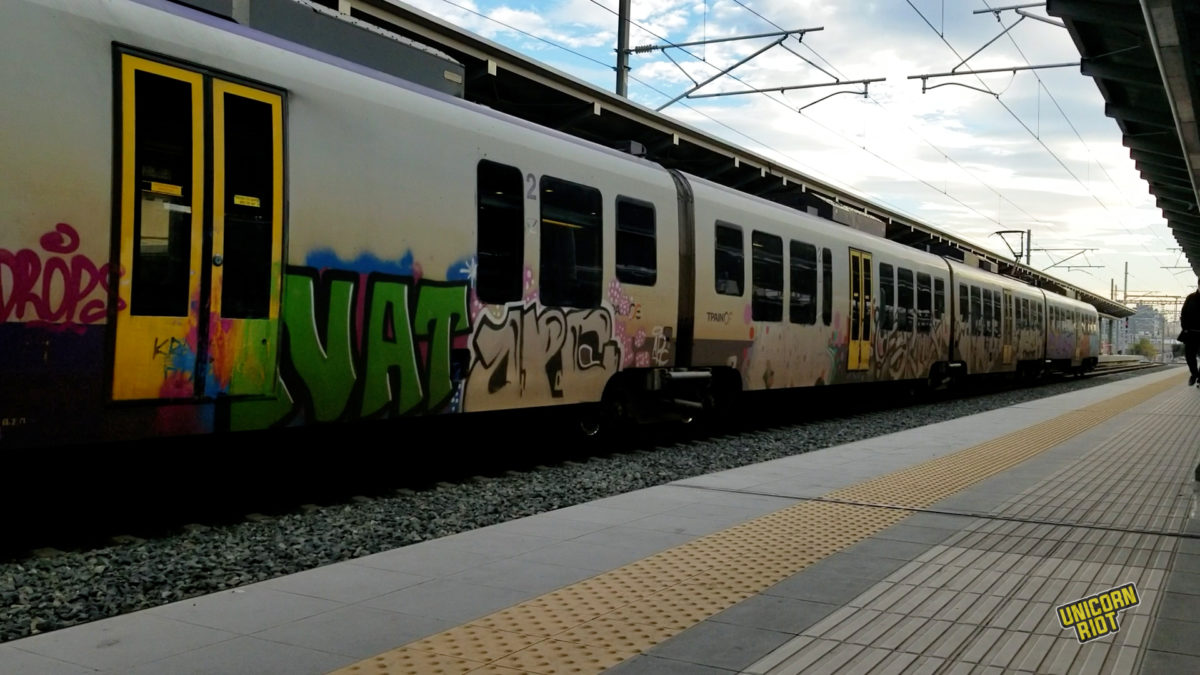
The Warnings – The crash as a self fulfilling prophecy
The fatal crash did not come about in a moment’s notice. The railway infrastructure and transport sector are in a very decayed states. Passenger testimonies over many years give a clear picture of the situation. Frequent breakdowns and “unexpected incidents” resulting in long stops, locomotive changes, power cuts, power cables falling on trains. Creaking trains, canceled and delayed services, emergency bus transfers, with no explanation and no compensation.
The voices of railway unions and rail workers were just as loud. Workers have long been aware of the shortcomings that created serious safety issues for both staff and passengers on the trains. Indeed, it appears that both drivers and station managers had sounded the alarm repeatedly up to a few weeks before the crash.
In particular, one of the unions belonging to the OSE federation, the Panhellenic Union of Traction Personnel, made up of the train engineers, had sent out legal notices citing the problems with railway safety on October 31 and November 16, 2022. Among other things they say:
“We demand immediate restoration of railway infrastructure, remote control, light signals, etcs and network safety which has been problematic for years.”
The Hellenic Railways Organization responded with a legal notice to the workers stating that everything they claim is slanderous and that they will suffer the consequences.
In their complaint on Feb. 7, 2023, the Democratic Unionist Railway Workers’ Union had warned:
“We will not wait for the accident to come to see them shedding crocodile tears while making observations. They… cannot tolerate this dangerous situation any longer. What else are they waiting for to intervene? What else has to happen?
Safety issues must be put on the front line. They must be at the center of workplace assemblies.”
One week later, on February 15, the European Commission decided to refer Greece to the Court of Justice of the European Union for failure to comply with rules on railway transport. It was five days after this referral that the Minister of Transportations Kostas Karamanlis was shamed live in parliament by those who raised Greek railway safety issues.
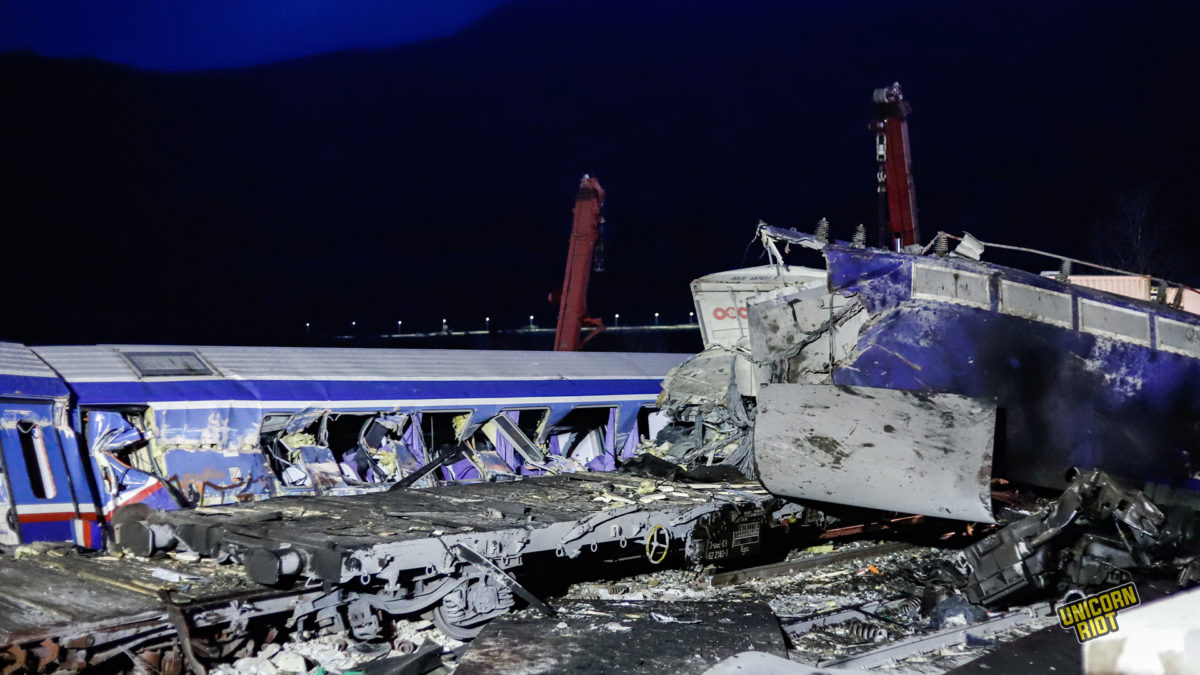

The History of Railway Transport Privatization in Greece – They put profit over life and call it liberalization
The privatization process of the state-owned Greek Railways Organization (OSE) has been underway for almost twenty years and is a deliberate policy of devaluation.
Routes and employee staff were reduced, and the Greek state contributed little in terms of funding for network maintenance, wagon maintenance and the construction sector of the organization. As a result, a public institution was forced to resort to borrowing from private banks with scandalously high interest rates; this naturally increased its debt. Thus, privatization was presented to be the only reasonable solution by and for the Greek state.
Initially, OSE was fragmented into pieces. Thus, in 2005, TRAINOSE was established as a subsidiary to provide passenger and freight transport services. In April 2013, all the shares of the company were fully owned by TAIPED (Public Asset Management Fund). Practically the Greek state had created, in the austerity years, a state-owned intermediary for the sale of state/public property. The left-wing government of SYRIZA came to complete the project in 2017. Finally, TRAINOSE was sold off to the Italian state-owned company “Ferrovie” for only 45 million euros. The company is financed with 50 million euros per year by the Greek state. On July 1, 2022, the company was renamed from TRAINOSE to Hellenic Train.
The process of privatization of rail networks and transport in Greece followed the main focus of the EU’s rail policy. The aim was full ‘liberalization’/de-nationalization/privatization to create a unified market for rail activities in which business groups could invest freely. The ‘liberalization’ of rail transport was promoted by a large package of EU directives and railway policy packages, which aimed at the gradual separation of infrastructure and operation, and the gradual removal of all barriers to the implementation of the single rail market.
In Greece, this policy was aimed, among other things, at the profitable freight lines on the Patras – Athens, Thessaloniki – Idomeni axis. These would become the subject of competition for large groups in order to promote the unified rail network. The infrastructure, which is being built with taxpayers’ money, is designed primarily for lucrative freight transport from ports to northern Europe. That is why, after all, the OSE remains in public ownership, to meet these needs. OSE is the manager of the national railway infrastructure. It is responsible for maintaining and expanding the network so that it can be exploited and used by business groups.
The Outbreak of the People – A new pluralist and intersectional justice movement sparks
The fatal crash itself, but also the irresponsible attitude of the New Democracy party-led government and the revelation of their lies, led to the outbreak of protests all over Greece.
Workers’ federations and trade unions under the auspices of the Communist Party were quickly activated, calling the first general strike on March 8. Railway workers, public transport workers, health workers, journalists, dockers, builders, teachers, miners, actors, cleaners and workers’ organizations from many other sectors supported the calls and took to the streets. They were joined by pupils, students, anarchist organizations, left-wing organizations and a large part of Greek society.
Hundreds of thousands of demonstrators in about 80 cities, from the north to the south, expressed their anger and sorrow, while demanding justice and accountability for the crime that had been covered-up.
Over the last month, Greece experienced the biggest wave of protests in the country in decades. Apart from the two major cities, Athens and Thessaloniki, where 100,000 and 30,000 people took to the streets respectively, the wave of protests spread to every corner of the country, and that is what makes it unprecedented. The big demonstrations of the last decade against austerity policies were mainly concentrated in the capital, Athens.
Strike mobilizations came to meet with student occupations of university buildings (more than 50 throughout Greece). School occupations and student actions combined with the art movement and theater occupations that have been fighting for months. Banners unfurled in football stadiums, graffiti artists painting trains black, feminist actions on March 8, with peaceful sit-ins and violent clashes with the police. Aside from the action in the streets, the internet allowed for the use of counter-information against the mainstream media.
Thus, a diverse, multiform and intersectional social movement unfolded, demanding justice against the policies of the state and private companies that put profit above human lives. The same scene was repeated on March 16 when the second general strike took place.
Large high school students’ mobilizations brought the country’s memories back to the December 2008 uprising following the police killing of Alexandros Grigoropoulos. Much like then, high school students rose up against a murdering state, occupied their schools and took to the streets feeling confronted by a government that devalues their lives.
The difference is that today’s high school students were born around 2008, so they have grown up within the economic crisis and insecurity and have not experienced any era of prosperity. They have seen their relatives die in understaffed hospitals in the midst of a pandemic. They’ve seen police chase them from public spaces and new bills excluding them from universities.
In any case, this is a very conscious generation. That the government sees this generation of youth in Greece as a threat can be seen from the arrests of students in the marches and school occupations. In fact, a new bill brings school occupations and protests under the umbrella of school violence, targeting and criminalizing students who resist.
A common chants in the marches are, “This crime will not be forgotten, we will be the voice of all the dead” and “You count profits and damages, we count human lives.” Among the many banners routinely displayed:
- “Our lives count, let there be no cover-up”
- “Their policies cost human lives”
- “They count profits and damages, we count human lives”
- “Their profits, our dead”
- “Transport, health, electricity, water belong to the people”
- “We have counted ourselves and we are less”
- “End of tolerance”
- “Down with the government of the killers”
Across many European cities public actions of remembrance have been held by Greek migrants.
Furthermore, a direct action on part of members of the Union of Engine Drivers saved another potential collision on March 13. Just two weeks after the fatal crash, the Hellenic Railways Organization once again, in repetition of the human error that caused the crash, gave the green light for a freight train to move on a non-remote-controlled part of the network without any additional instruction. Union members immediately intervened by quickly canceling the route.
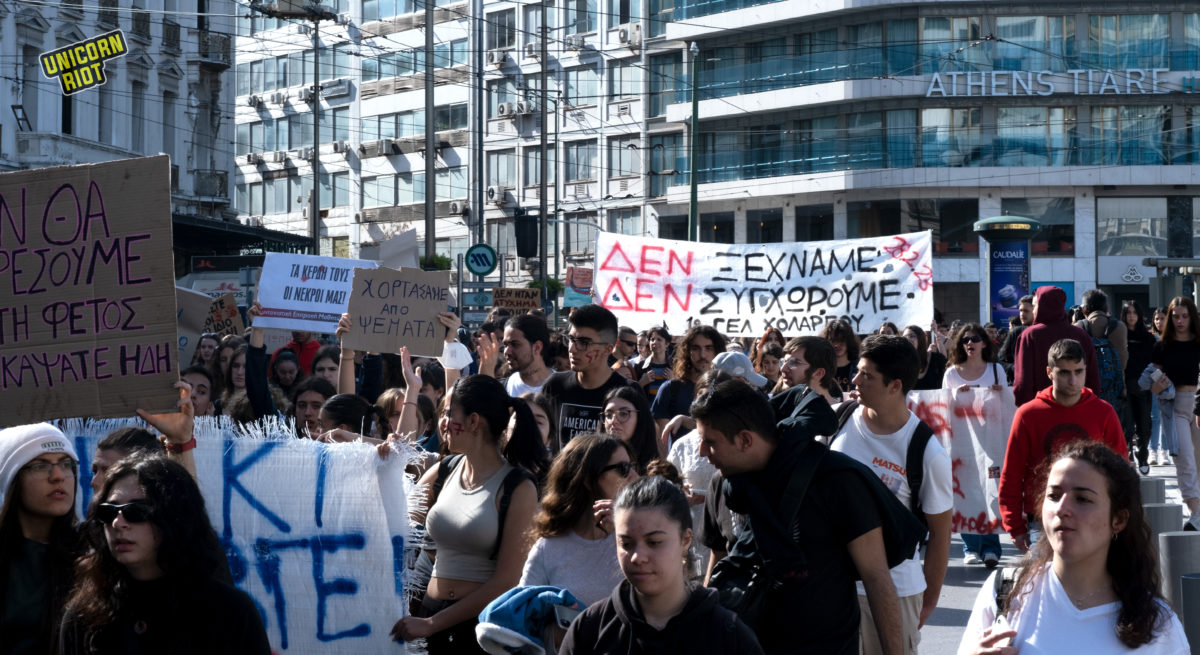
Repression
The militarized management of this crisis was the only way forward for the government of Prime Minister Kyriakos Mitsotakis. The repression was concentrated in Athens and Thessaloniki. Initially, wanting to make it difficult for the protesters to access the centralized Syntagma Square, as has happened in the past, they decided to close central metro stations.
Since this strategy proved ineffective, the police resorted to a common alternative tactic. Taking as an excuse attacks by small groups of demonstrators, the police assaulted unprovoked and broke up the big demonstrations. Particularly in Athens this happened with frightening brutality.
Flash-bang grenades, tear gas, beatings of demonstrators and violent arrests occurred frequently. Injuries to journalists from flashbang grenades also increased.
On March 16 in Athens, an unmarked police car rammed two citizens, seriously injuring them. Immediately afterwards, a police crane moved at high speed on a main road and by luck did not run over demonstrators. Police also blocked the student occupation of the University of Athens, leaving students deprived of food for six days as they arrested anyone who tried to approach the building.
[Links to videos embedded above: 1, 2, 3, 4]
The Relaunch of the Train Services: Another Communication Show
On April 3, the official relaunch of Hellenic Train transport services took place at Athens Central Station, in the presence of the new Minister of Transport and many TV cameras. This restart was more of a communication show than a real reassurance to employees and passengers that the services are now operating in compliance with safety rules. The new minister boarded and was photographed in the driver’s carriage. He told the TV cameras that the aim is “to shed a lot of light on the issue of the accident and to highlight the responsibilities where they exist. The second is to have a safe restart. The third is to raise the safety level of the railways to a more permanent level.” He then disembarked at the very next stop.
Interviews were televised in the mainstream media of passengers saying they felt no fear whatsoever. Yet, it was revealed immediately afterwards by independent media that two of the ‘ordinary citizens’ making statements to the cameras were actually members of the ruling New Democracy party.
The reality was quite different from what people saw on their TV screens. The train, according to independent reports, was almost empty.
Since the crash, the announced timetable to restart all trains has continued to be pushed back. The scheduled routes are also much less than what the government had announced last week, as the Union of Hellenic Train’s engineers (PEPE) were not given the necessary assurances that they were asking for as a necessary condition for the total restart of the services. Read a letter written by the train drivers, here.
The chairman of the drivers and head of the Hellenic Train Drivers’ Union (PEPE), Costas Genidounias, said that they are starting with reduced speeds, without remote control and reduced services, after some initial safety works were carried out.
According to the chairman, the restart framework at the moment in terms of safety measures is as follows:
“Traffic will operate from station to station, without remote control, with two station masters this time at all stations, with reduced speeds, and it has been progressively announced that remote control will be completed by the autumn of 2023, when the whole system will be made available for use. We are monitoring this on a daily basis and will therefore keep passengers informed of the progress of these projects so that they have a full picture of exactly what is happening on the railways.”
What’s Next?
The evolution of the struggle for justice for the 57 dead remains completely open. Greek society is once again a boiling vessel that can burst at any moment. Some of the families of the victims have already filed lawsuits, so another legal struggle is beginning, one that is already supported by the social movements on the street. At the same time, a public dialogue has started on privatization and also on nationalization.
The question arises as to whether nationalizations are a real solution, especially since the state-owned companies are now also operating on clearly capitalist terms of increasing profit at all costs without putting the needs of society first. It is in this context that voices are once again beginning to emerge that propose control and management by the workers and society themselves, based on the needs of the many.
For more from Greece, see our archives.
Follow us on Twitter, Facebook, YouTube, Vimeo, Instagram, Mastodon and Patreon.
Please consider a tax-deductible donation to help sustain our horizontally-organized, non-profit media organization:

The post ‘It was a crime, not an accident!’ – Deadly Greek Train Crash Sparks Justice Movement appeared first on UNICORN RIOT.
by Unicorn Riot via UNICORN RIOT

No comments:
Post a Comment